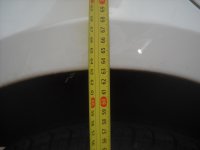Okay, this is my first post, although I have read a lot of posts on this forum over time.
Anyway, I have a 2008 Fiat Panda dynamic 1.2, and drove over a deep pothole. The force fractured my rear axle and the drivers side spring cup support on the axle cracked and hung worryingly at about 45 degrees towards the floor.
So I had to bite the bullet and replace the axle with a brand new axle. This has been done. From the original axle, I had to salvage the triangular axle support brackets that attach to the body with 3 bolts and I also salvaged the stub axle/brake drum components. Brake pipes, hoses, coil springs and the like were renewed. All bolts have been torqued.
However, my question is in relation to the highest point of the rear wing to the floor. I have seen the Fiat repair manual and it says it should be 626mm. My measurements read about 670mm. I'm wondering whether in fact my ride height is in fact too high or whether this is a standard measurement?
If my height is too high... will this mean I need to jack up my car onto axle stands, loosen the axle-to-axle mounting support bracket bolt (both passenger and drivers side), lower car to ground and then torque them again to 115nm?
Advice most appreciated!
Anyway, I have a 2008 Fiat Panda dynamic 1.2, and drove over a deep pothole. The force fractured my rear axle and the drivers side spring cup support on the axle cracked and hung worryingly at about 45 degrees towards the floor.
So I had to bite the bullet and replace the axle with a brand new axle. This has been done. From the original axle, I had to salvage the triangular axle support brackets that attach to the body with 3 bolts and I also salvaged the stub axle/brake drum components. Brake pipes, hoses, coil springs and the like were renewed. All bolts have been torqued.
However, my question is in relation to the highest point of the rear wing to the floor. I have seen the Fiat repair manual and it says it should be 626mm. My measurements read about 670mm. I'm wondering whether in fact my ride height is in fact too high or whether this is a standard measurement?
If my height is too high... will this mean I need to jack up my car onto axle stands, loosen the axle-to-axle mounting support bracket bolt (both passenger and drivers side), lower car to ground and then torque them again to 115nm?
Advice most appreciated!
Last edited:


